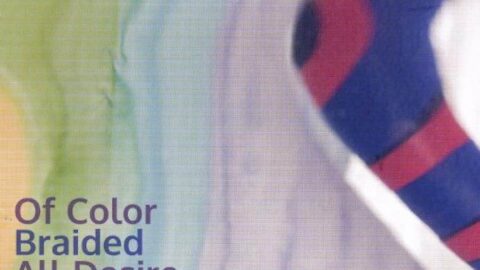In today’s eclectically-aural world, rarely is a reviewer afforded the opportunity to rectify the misguided judgments of music’s past. Indeed, in the early 20th century, harsh commentary often accompanied the New Viennese School’s exploration of artistic representations of the human unconscious. Schoenberg and his colleagues subsequently retreated to their progressive Society for Private Musical Performances to freely test their controversial sounds. However, no longer is the bold composer forced to retreat to the laboratory fearful of the public’s scrutiny. The proliferation of global ideologies has, in effect, given composers of any style an audience who will appreciate his or her work. Eric Moe and the collaborators featured on Of Color Braided All Desire are testament to music’s societal progress since late-romanticism. Moe’s music is a fitting tribute to the emancipation of conventionalism sought by the New Viennese School. The listener is removed from classical rigid structures; consequently, we experience a more subjective, more human soundscape—a clear recollection of expressionism.
Eric Moe’s record begins with the four-part composition “Of Color Braided All Desire.” The piece is centered around the lyrical words of famed poet May Swenson and sung by soprano Christine Brandes. Swenson’s lines illustrate human sensations in metaphorical terms, pushed to irrational extremes through the medium of Moe’s characteristically expressionistic accompaniment. The first movement, “Swimmers,” is riddled with chaotic diction such as, “Tossed by the muscular sea, we are lost.” Violent, rushing, and receding motion in the strings precede Brandes’ vocals. However, the soprano’s entry into the foray does not provide a sense of tonal order; though Swenson’s words are sung, the articulations and stressed points are not organized around a tonal center. Rather, Moe employs sprechgesang, an early 20th century technique in which the divide between speech and song are confounded. This style is continued in “Of Color Braided All Desire’s” three subsequent tracks.
“Four Word Lines” follows “Swimmers’” urgent, rapid movement with a thin, condensed texture maintained by the string quartet’s sparse instrumentation. Listening, I am reminded of the seemingly desolate works of Anton Webern, particularly his Six Bagatelles for String Quartet. Upon Webern’s composition’s publication, Schoenberg, defended such moderation claiming that it concentrated minimal musical gestures to heightened levels of expression. Moe’s application of this texture to Swenson’s poetry is most appropriate for this compression. Lines such as “Their brown power makes a breeze go over my skin,” take on a drama of their own with mournful syllables drawn-out in wavering, goosebump-inducing vibrato.

Gamboling, unexpected punctuations and stresses pierce the final two numbers of “Of Color Braided All Desire” (“Fireflies” and “Incantation”). Swenson’s poems, personified through voice, fantasize about such subjects as the “love winks” of fireflies and bounce such claims as, “In black sleep brightness keep.” The fantastic phrasing, however, does not suggest a universal, relatable condition which listeners might attach his or her personal meaning to; more readily, the dialogue is a seemingly spontaneous stream of consciousness of the speaker herself. One is instantly reminded of Schoenberg’s notorious, introspective clown: in Pierrot Lunaire, pining over the moon, Pierrot reflects over love, blasphemy, and his haunting past. Just as Pierrot dances from perception to perception, so to does the Swenson/Moe figure ricochet between musings. It is this non-linear design, which is perhaps best representative of expressionism. Swenson’s flighty poems, combined with Moe’s disoriented tonality, effectively explore the innate, beautiful irrationalism of unconscious thinking.
“Gong Tormented,” the fifth track, offers a refrain from the intense intimacy of “Of Color Braided All Desire.” The piece is composed solely of percussive instrumentation, featuring, among others, gong, tam-tam, and cymbal. The resonances seem distant and nearly suspended. Sudden bursts of knocks and clashes suggest a yearning for release from captivity. “Danger: Giant Frogs” too shares a similar liberal trial of different combinations of percussive sounds. The number consists not of one single, thematic element; rather, it is comprised of many disparate musical premises.
Tracks six and seven return to Moe’s fashion of placing stringed instruments in uneasy situations. In “And Life Like Froth Doth Throb,” the viola and cello neurotically trade off between persistent staccato repetitions of a singular note. The work’s perpetual motion incites a frantic anxiety in the listener. “The Salt of Broken Tears” is similarly driving and deliberate. The opening passage, a series of dynamically rising chords, bit at the end by sharp, jolting harmonies, is repeated several times, as if struggling for resolution. Indeed, repetition serves a related function as it does in “And Life Like Froth Doth Throb.” Persistent chugging of singular notes in one or more voices creates a restless unsafe feeling—as if one is being chased.
Though not without their own unique characteristics, Moe’s pieces featured on Of Color Braided All Desire demonstrate a similar ambition: to free music and sound from rigid institution. The introductory piece, after which the album is named, is an acknowledgement, recognizing the legacy of expressionism and its tired journey towards acceptance into critical appreciation. In the following works, Moe expands on this idea, showing us that despite familiar musical forms, a composition is yet capable of drawing significant emotional arousal in the listener.
























